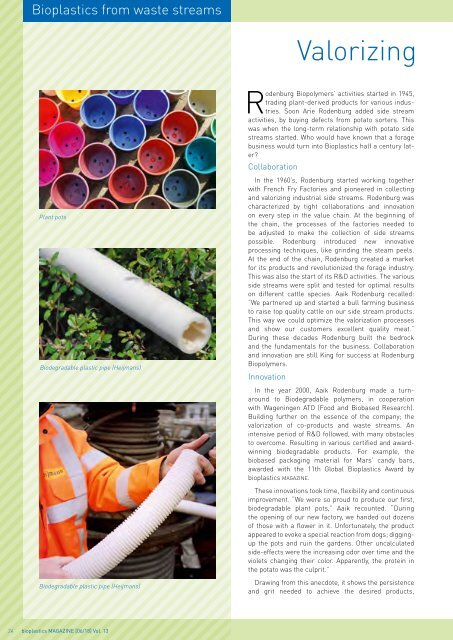Issue 06/2018
bioplasticsMAGAZINE_1806
bioplasticsMAGAZINE_1806
Create successful ePaper yourself
Turn your PDF publications into a flip-book with our unique Google optimized e-Paper software.
Bioplastics from waste streams<br />
Valorizing<br />
Plant pots<br />
Biodegradable plastic pipe (Heijmans)<br />
Rodenburg Biopolymers’ activities started in 1945,<br />
trading plant-derived products for various industries.<br />
Soon Arie Rodenburg added side stream<br />
activities, by buying defects from potato sorters. This<br />
was when the long-term relationship with potato side<br />
streams started. Who would have known that a forage<br />
business would turn into Bioplastics half a century later?<br />
Collaboration<br />
In the 1960’s, Rodenburg started working together<br />
with French Fry Factories and pioneered in collecting<br />
and valorizing industrial side streams. Rodenburg was<br />
characterized by tight collaborations and innovation<br />
on every step in the value chain. At the beginning of<br />
the chain, the processes of the factories needed to<br />
be adjusted to make the collection of side streams<br />
possible. Rodenburg introduced new innovative<br />
processing techniques, like grinding the steam peels.<br />
At the end of the chain, Rodenburg created a market<br />
for its products and revolutionized the forage industry.<br />
This was also the start of its R&D activities. The various<br />
side streams were split and tested for optimal results<br />
on different cattle species. Aaik Rodenburg recalled:<br />
“We partnered up and started a bull farming business<br />
to raise top quality cattle on our side stream products.<br />
This way we could optimize the valorization processes<br />
and show our customers excellent quality meat.”<br />
During these decades Rodenburg built the bedrock<br />
and the fundamentals for the business. Collaboration<br />
and innovation are still King for success at Rodenburg<br />
Biopolymers.<br />
Innovation<br />
In the year 2000, Aaik Rodenburg made a turnaround<br />
to Biodegradable polymers, in cooperation<br />
with Wageningen ATO (Food and Biobased Research).<br />
Building further on the essence of the company; the<br />
valorization of co-products and waste streams. An<br />
intensive period of R&D followed, with many obstacles<br />
to overcome. Resulting in various certified and awardwinning<br />
biodegradable products. For example, the<br />
biobased packaging material for Mars’ candy bars,<br />
awarded with the 11th Global Bioplastics Award by<br />
bioplastics MAGAZINE.<br />
These innovations took time, flexibility and continuous<br />
improvement. “We were so proud to produce our first,<br />
biodegradable plant pots,” Aaik recounted. “During<br />
the opening of our new factory, we handed out dozens<br />
of those with a flower in it. Unfortunately, the product<br />
appeared to evoke a special reaction from dogs; diggingup<br />
the pots and ruin the gardens. Other uncalculated<br />
side-effects were the increasing odor over time and the<br />
violets changing their color. Apparently, the protein in<br />
the potato was the culprit.”<br />
Biodegradable plastic pipe (Heijmans)<br />
Drawing from this anecdote, it shows the persistence<br />
and grit needed to achieve the desired products,<br />
24 bioplastics MAGAZINE [<strong>06</strong>/18] Vol. 13


















